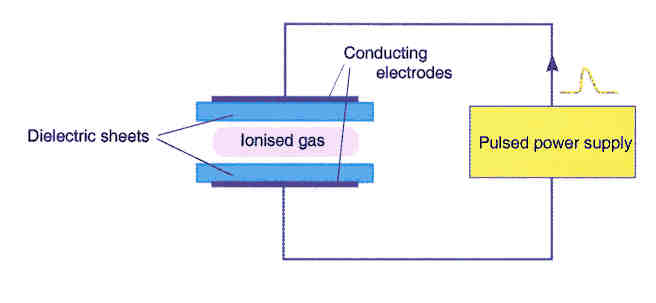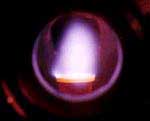|
Our
research in plasma physics has two directions of focus 1) fusion
plasmas, which aims to develop an alternative and clean source of
energy based on nuclear fusion and 2) materials processing plasmas,
directed towards development of plasma processes to produce new
materials with tailored properties or modify surfaces with ion implantation.
Plasma diagnostics such as laser induced fluorescence (LIF) and
electrostatic energy analysis are used to study the properties of
plasmas.
>
Plasma confinement
Material to
be supplied.
> Fusion
Plasmas
The
unlimited supply of energy promised by the fusion program is yet
to be realized, but the first commercial plant will almost certainly
be demonstrated this century. We are collaborating with ANU in
the Heliac project. This project is trialling a new magnetic field
environment for plasma confinement which is a practical alternative
to the well-known Tokamak. Work is also underway to develop a
small fusion reactor in the Desktop Fusion project.
Contact:
A/Prof. Brian James, b.james@physics.usyd.edu.au.
> Desktop
Fusion
Another
route to fusion which can be demonstrated on a much smaller scale
is the so-called "desktop" fusion process. A plasma
is generated and the ions are attracted into a central point by
an electric field. Because of the spherical symmetry the ions
meet at the center of the device, as shown in the figure. Fusion
occurs releasing neutrons from the central region.
Contact:
Dr Joe Khachan, j.khachan@physics.usyd.edu.au.
> Dielectric
barrier discharges
A Dielectric
Barrier Discharge (DBD) is a gas discharge between two electrodes
separated by one or more dielectric layers and a gas-filled gap.
A typical DBD in which the electrodes are both covered with a
dielectric layer is shown in the figure. When a high voltage is
applied to the electrodes the electric field in the gap ionises
the gas. The ions and electrons produced by this electric discharge
are attracted towards the electrodes of opposite polarity and
form a charge layer on the dielectric surface. These charges cancel
the charge on the electrodes so that the electric field in the
gap falls to zero and the discharge stops. Devices based on this
process have applications in areas as diverse as plasma displays,
photo-chemistry and broad area surface treatment in industry such
as sterilisation and surface etching.

DBD
research program: The Plasma Physics Team is investigating
DBDs designed for two applications: DBDs for Plasma Display Panels
The application of DBDs with the most commercial potential is
the plasma display panel (PDP), a flat, high-resolution TV visual
display unit which can be scaled up to produce large pictures.
PDPs of >100 cm diagonal for domestic use are currently on the
market. We are investigating the growth of the discharge in a
small DBD similar to that in a PDP. The picture shows a series
of images of the discharge in argon.
Need picture
Efficient high-power ultraviolet lamps DBDs in xenon gas, when
driven by very short voltage pulses are efficient sources of UV
radiation. We are collaborating with Macquarie University on developing
large area xenon DBD lamps for industrial applications.
> Materials
processing plasmas
 The
ions produced in plasmas can be used to modify surfaces and to
create new layers or films on surfaces. The effect depends on
the ion flux, impact energy and the nature of the ion-surface
interaction. The production of diamond is currently under investigation.
Previous work has used microwave plasmas but current work is directed
towards diamond formation by directing ion beams at the growth
surface. The
ions produced in plasmas can be used to modify surfaces and to
create new layers or films on surfaces. The effect depends on
the ion flux, impact energy and the nature of the ion-surface
interaction. The production of diamond is currently under investigation.
Previous work has used microwave plasmas but current work is directed
towards diamond formation by directing ion beams at the growth
surface.
Contact:
Prof. Marcela Bilek, mmmb@physics.usyd.edu.au.
> Fuse
spectroscopy
Brian James
and Ian Falconer are rounding off work on a spectroscopic measurement
of the electron temperature and density of the plasma in high-voltage,
high current fuses. This work is in conjunction with Tony Stokes
from Electrical Engineering at the University of Sydney.
> Laser
Induced Fluorescence
The
ion energy and electric fields present in a plasma determine the
effects which can be achieved in plasma-surface interactions.
It is important to investigate these parameters without disturbing
the conditions in the plasma. Crossed laser beams can be used
to define a localized region in the plasma and generate fluorescent
light from the atom-photon interactions. This light has a Doppler
shift dependent on the velocity in the line of sight and so can
be used to measure the velocities and hence energies of the atoms
or ions. A sheath always surrounds an electrode or work-piece
being treated in a plasma and determines the ion implantation
dose and process stability in Plasma Immersion Ion Implantation
(PIII). LIF can reveal the conditions in the sheath without disturbance.
|



 The
ions produced in plasmas can be used to modify surfaces and to
create new layers or films on surfaces. The effect depends on
the ion flux, impact energy and the nature of the ion-surface
interaction. The production of diamond is currently under investigation.
Previous work has used microwave plasmas but current work is directed
towards diamond formation by directing ion beams at the growth
surface.
The
ions produced in plasmas can be used to modify surfaces and to
create new layers or films on surfaces. The effect depends on
the ion flux, impact energy and the nature of the ion-surface
interaction. The production of diamond is currently under investigation.
Previous work has used microwave plasmas but current work is directed
towards diamond formation by directing ion beams at the growth
surface.